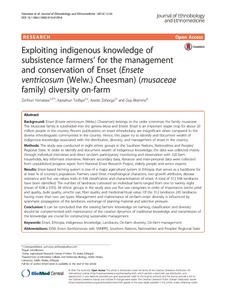Resource information
reproduction in any medium, provided you give appropriate credit to the original author(s) and the source, provide a link to the Creative Commons license, and indicate if changes were made. The Creative Commons Public Domain Dedication waiver
(http://creativecommons.org/publicdomain/zero/1.0/) applies to the data made available in this article, unless otherwise stated.
Enset (Ensete ventricosum (Welw.) Cheesman) belongs to the order sctaminae, the family musaceae. The Musaceae family is subdivided into the genera Musa and Ensete. Enset is an important staple crop for about 20 million people in the country. Recent publications on enset ethnobotany are insignificant when compared to the diverse ethnolingustic communities in the country. Hence, this paper try to identify and document wealth of indigenous knowledge associated with the distribution, diversity, and management of enset in the country.
Methods: The study was conducted in eight ethnic groups in the Southern Nations, Nationalities and Peoples’ Regional State. In order to identify and document wealth of indigenous knowledge, the data was collected mainly through individual interviews and direct on-farm participatory monitoring and observation with 320 farm households, key informant interviews. Relevant secondary data, literature and inter-personal data were collected from unpublished progress report from National Enset Research Project, elderly people and senior experts.
Results: Enset-based farming system is one of a major agricultural system in Ethiopia that serves as a backbone for at least ¼ of country’s population. Farmers used three morphological characters, two growth attributes, disease resistance and five use values traits in folk classification and characterization of enset. A total of 312 folk landraces have been identified. The number of landraces cultivated on individual farms ranged from one to twenty eight (mean of 8.08?±?0.93). All ethnic groups in the study area use five use categories in order of importance: kocho yield and quality, bulla quality, amicho use, fiber quality and medicinal/ritual value. Of the 312 landraces 245 landraces having more than two use types. Management and maintenance of on-farm enset diversity is influenced by systematic propagation of the landraces, exchange of planting material and selective pressure.
Conclusion: It can be concluded that the existing farmers’ knowledge on naming, classification and diversity should be complemented with maintenance of the creative dynamics of traditional knowledge and transmission of the knowledge are crucial for constructing sustainable management.


